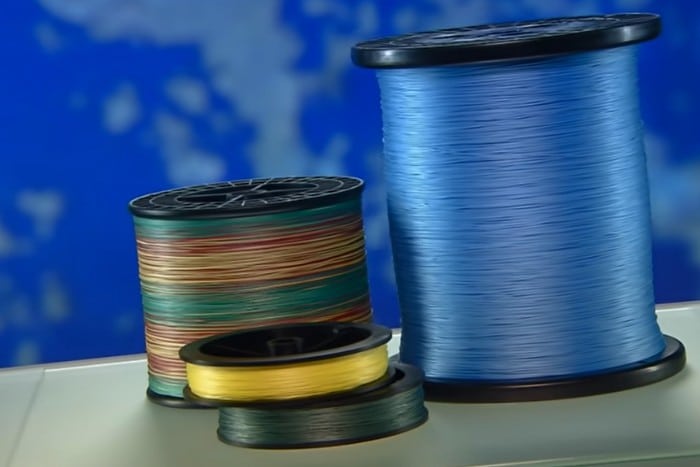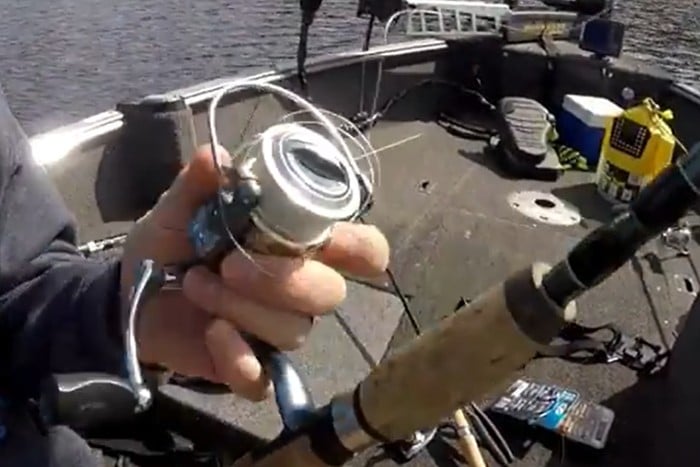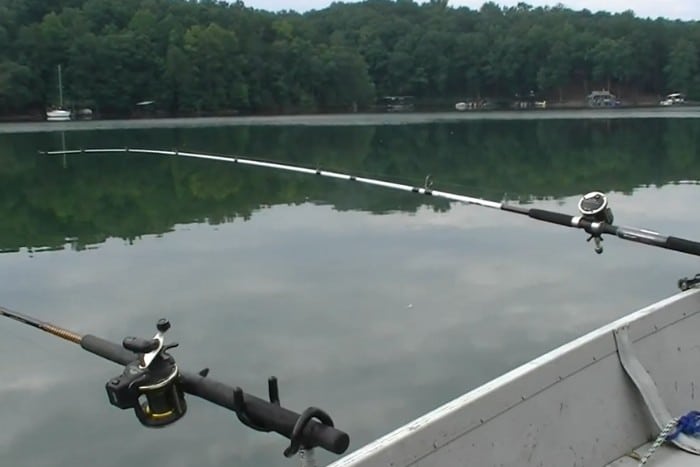Floating fishing line is essential to present baits and lures on the water’s surface rather than sinking below the surface. Topwater frogs, poppers, walking baits, flies, and buzz baits are a few examples where floating lines help keep the lure at the top where it is most effective.
Braided and monofilament fishing lines typically float, while fluorocarbon sinks quickly in water. How well a line will float depends on thickness, material, and if treated with additives to increase buoyancy. Embedded bubbles, foam particles, or special coatings can impact if a line floats.
Choosing the right floating line is vital to perfecting your topwater presentation and can keep the lures from looking unnatural and spooking fish.
What Causes a Fishing Line to Float or Sink?
Understanding why fishing lines float or sink is essential for anglers to choose the right line for their fishing needs.
The different reasons a line will float can impact how it floats, meaning that the lines are best suited for different scenarios.
Below are four reasons that impact a fishing line’s ability to float and the best uses for each.
1. Different Materials Have Different Densities
The material of a fishing line significantly impacts its density, which affects its ability to float.
Some materials, such as monofilament, have a lower density and float, while others, such as fluorocarbon, have a higher density and sink.
This property of different materials is helpful for anglers to select the right fishing line that best suits their fishing needs. For lures that are best fished deep in the water, a denser line will help the line sink faster.
Braid is also a low-density line and typically floats well on the water’s surface.
If you are looking for a floating fishing line, go with braid or monofilament rather than fluorocarbon when not considering other factors.

2. Diameter of the Fishing Line Impacts if it Floats
The diameter of the fishing line also plays a significant role in determining if it will float or sink. Larger-diameter lines tend to float, while smaller-diameter lines tend to sink.
Some lines do this because larger diameter lines have more surface area exposed to air, which helps them float.
On the other hand, smaller diameter lines have a smaller surface area exposed to air, making them sink.
Diameter particularly affects monofilament fishing lines, where 20-pound and greater test lines have a surprising capability to float and support lures compared to thin-diameter lines.
3. Manufacturer Additives Impact Flotation
Some fishing line manufacturers add special additives to their lines to enhance their flotation or sinking properties.
For example, manufacturers may add buoyant materials, such as foam, to floating lines to increase their flotation.
Fishing manufacturers can add air inside the line to provide more buoyancy, giving the line more help to stay at the water’s surface.
Copolymer lines can combine a strong base fishing line with a coating of another material for the best floatation ability.
These additives can significantly impact the flotation of a fishing line and should be considered when selecting the right line for a particular fishing scenario.
4. Problems With Floating Fishing Lines
Although floating fishing lines offer several advantages, such as the ability to detect bites, some problems are associated with them.
Floating lines can create visible wakes in the water, spooking fish and making it harder to catch them. Additionally, floating lines can become tangled and cause problems with the fishing gear.
Another problem, specifically with monofilament, is the material’s high amount of stretch.
Over long distances, it can be difficult to set the hook because of how stretchy the material is, and it can result in lost fish. Braid is the way to go if you are fishing over long distances and want a floating line.

When Is Using a Floating Line Better Than a Sinking Line?
Fishing lines play a crucial role in the success of any fishing trip. There are two main fishing lines – floating and sinking- each with advantages and disadvantages.
Below are a few reasons you should use a floating line rather than a sinking line.
1. Top Water Baits
One of the best situations to use a floating line is when fishing with top water baits. These baits are designed to float on the water’s surface and create a commotion that attracts fish.
A floating line helps to keep the bait on the surface, making it easier for anglers to detect bites and keep the presentation as realistic as possible.
Additionally, a floating line allows anglers to make longer casts, which is beneficial when fishing for species that are wary of boats or anglers.
Braid is a floating line that’s good for one of the most popular topwater baits: frogs. When using topwater frogs, you often need to cast deep into weeds and muscle the fish out.
And when using braid, you get a much higher tensile strength in a smaller form.
2. To Cause A Slower Sinking Presentation
Another situation in which a floating line is better than a sinking line is when anglers want to cause a slower sinking presentation.
For example, anglers who are fishing for species that are more likely to bite during a slower descent may prefer to use a floating line.
The floating line will allow the bait to sink slowly, allowing anglers more time to detect bites and set the hook.
Texas rigs with braid or monofilament sink slower than with fluorocarbon, which can help when the fish are finicky and make enough of a difference on those days when the fishing is tough.
3. Surface Trolling
Surface trolling is a fishing technique that involves pulling lures or baits along the water’s surface.
This technique is best performed with a floating line as it allows anglers to keep the lure or bait at the correct depth, making it more effective and increasing the chances of catching fish.
Additionally, surface trolling is often used to target species such as marlin, sailfish, and tuna, which are more likely to bite on the surface.

4. Better Bite Detection
Finally, using a floating line is often better than using a sinking line when it comes to detecting bites.
A floating line makes it easier for anglers to detect bites because it provides more visibility, allowing anglers to see when their line is moving or twitching.
This movement is particularly useful when fishing for less aggressive species that take the bait more slowly, such as trout or cold-water bass.
Floating lines can also come in bright colors, making them more visible and easier to detect bites.
Conclusion
In conclusion, a floating line is better than a sinking line in specific fishing scenarios, such as when fishing with top water baits, causing a slower sinking presentation, surface trolling, and detecting bites.
Understanding when to use a floating line and when to use a sinking line is crucial for anglers to be successful and enjoy their fishing experiences.
Whether anglers choose a floating or sinking line, selecting the right line best suits their fishing needs and fishing scenario is essential.
